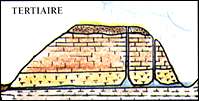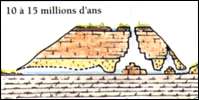

KARSTOLOGY OF THE CAVE
Once the Cretaceous limestone emerged, and were thus subjected to the action of surface waters, the karstification process, specific to this type of ground, could develop. The more or less acidic meteoric waters, by seeping into the fine discontinuities of the rock, (joints of stratification, fractures of all kinds), slowly dissolved the soluble limestone, widening the canals by creating, over the centuries, more or less vast underground cavities (caves chasms, etc.).
The course of sub-surface water can be long and irregular and lead to springs located at the bottom of certain valleys.
 |
 |
 |
 |
At many times during the tertiary period, the development of karst must have been significant. It is likely that much of the meteoric waters were drained by underground canals. |
Today, there is a great deal of evidence of this ancient water circulation system. |
But most often, it is no longer in harmony with the landscape and existing drainage; and is plugged by large accumulations of sandy-clay soil. During the Quaternary period, the karstification phenomenon continued to develop and evolve, with interruptions caused by glacial periods however, relentlessly hollowing out the numerous caves that delight today's cavers and well-informed tourists. |
At Proumeyssac, the initial splitting of the massif resulted in a south-east / north-west subsurface flow. The mechanical and chemical erosion of the river contributed to the evolution of its flow towards the lower level of the hill taking advantage of the joints of stratification and the pre-existing fractures. Combined with this phenomenon, the gradual collapse of the roof took place stratum by stratum, from bottom to top, giving the cavity a dome structure, right up to its opening towards the outside. The debris obstructing the bottom of the cave is evidence of that mechanism; its base remaining subject to the sapping of the river flow which is currently not visible. It is the perfect example of a sink-hole. |
|
From a geological point of view, past the sandy clay zone of fragmental spreading at the top of the cave, we descend crossing the strata of sandstone to flint, with beds of marl, from the Maastrichtian stage, for about 30 meters. They rest on the Campanian limestone which likely forms the base level of the cavity. The nearly horizontal general dip intersected by the vertical lines of fractures where water seeps through can be clearly observed. That seepage is what formed the impressive flowstone structures such as: the Medusa, the Mermaid or the draperies, and continue to sustain them. |